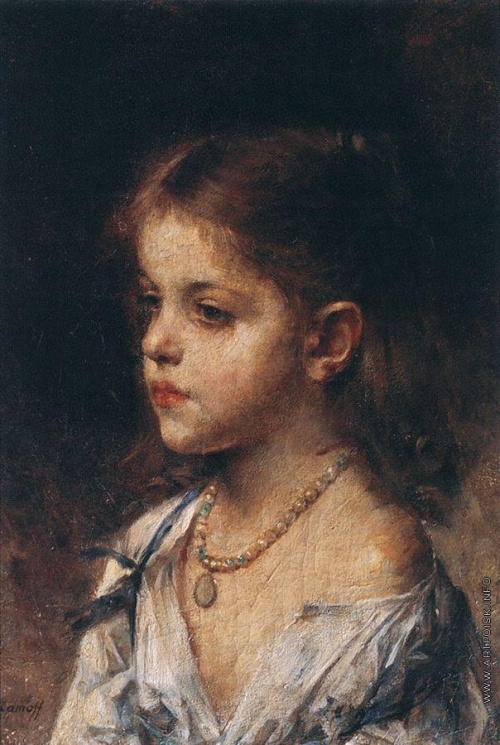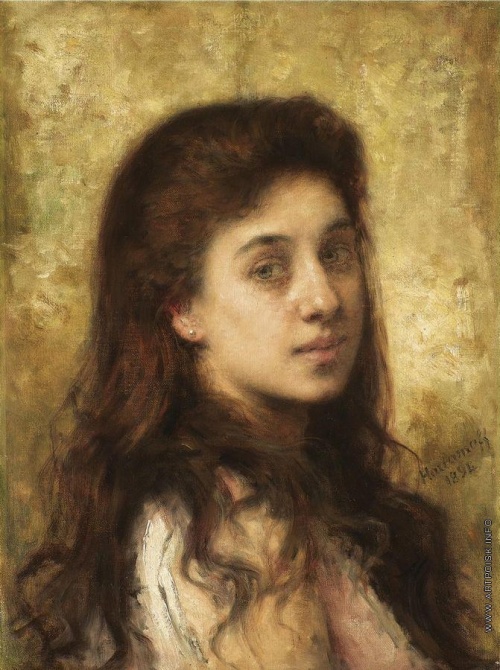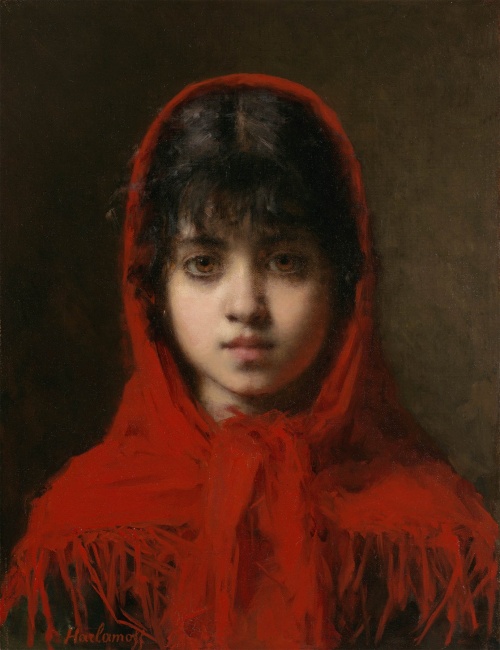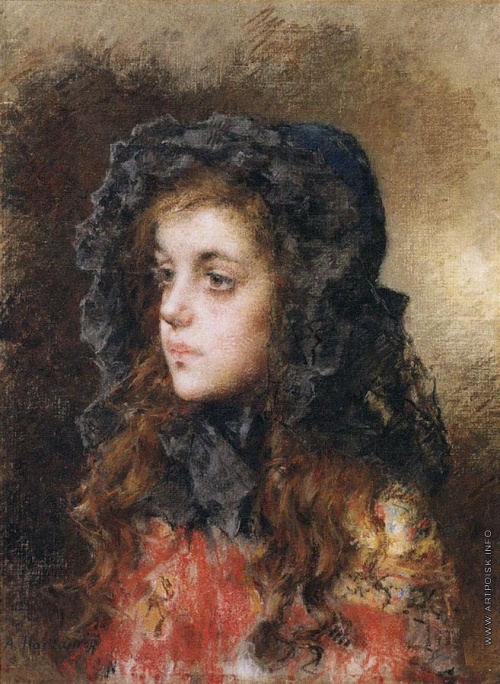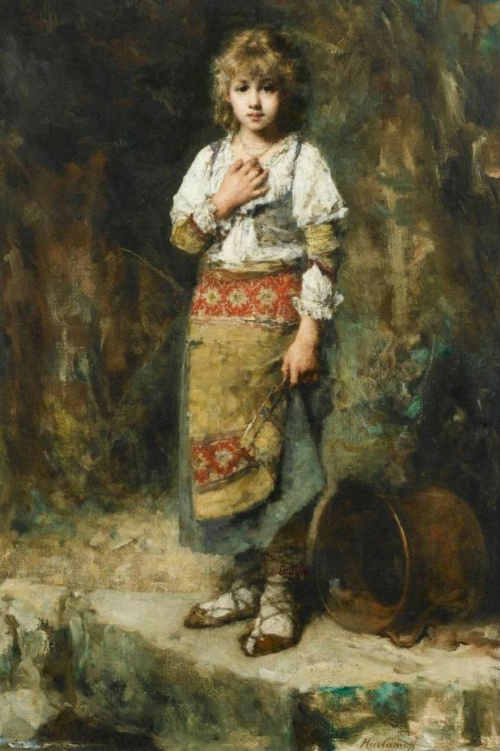Artist Alexey Kharlamov (137 works)
Разрешение картинок от 250x305px до 3305x4000px
Collection of works by the artist Alexei Alekseevich Kharlamov (1840 - 1925).
Alexey Alekseevich Kharlamov (October 18, 1840, village of Dyachevka, Petrovsky district, Saratov province, Russian Empire - April 10, 1925, Paris, France) - Russian artist, master of portraiture. Born into a large family of a serf peasant. He was his parents' seventh child. Soon after his birth, the owners decided to sell his parents to another landowner, while keeping the children for themselves. Little Alyosha was lucky - due to his infancy, he could not be separated from his mother and therefore was sold along with his parents. In 1850, Alexei’s parents, along with him and two younger children, received freedom. Soon the family moved to St. Petersburg. In St. Petersburg, at the age of 12, Alexey began taking drawing lessons from a student at the Academy of Arts, V.Ya Afanasyev. He tries very hard in his studies and in 1854 he enters the Imperial Academy of Arts, where he becomes a student of Professor A. T. Markov, a representative of late classicism. For success in drawing and painting Alexey Alekseevich 1857 and 1862 receives two Small silver medals, and in 1863 - two Large silver medals. In 1866, Kharlamov received a Small Gold Medal for the painting “The Baptism of the People of Kiev,” and in 1868, a Large Gold Medal for the painting “The Return of the Prodigal Son to His Parental Home.” In 1869, Kharlamov, among the best graduates of the Academy, received the right to a retirement trip abroad. Alexey Alekseevich travels a lot around Europe: visits art museums in Germany, Great Britain, France, Spain, Italy, Switzerland, Belgium, and Holland. Lives in Paris for some time. In 1871-1872, by order of the museum of the St. Petersburg Academy of Arts, he made a copy of Rembrandt’s painting “The Anatomy Lesson of Doctor Tulp” in the Mauritshuis Palace in The Hague. In 1872, Kharlamov joined the Association of Traveling Art Exhibitions. Subsequently, the artist will regularly send his paintings to the annual exhibitions of the Peredvizhniki in St. Petersburg. At the end of 1872, the artist returned to Paris, where he entered the studio of the fashionable French artist Leon Bonna. The aristocratic and bourgeois salons of the Third Republic were filled with portraits and historical paintings of Bonn. This fashionable painter successfully conveyed an external resemblance to nature and at the same time retained the appearance of “museum” art. Paying tribute to his mechanical skill, a contemporary called Bonn "an excellent, monotonous and trivial artist." Following Bonn, Kharlamov successfully imitated in his works the appearance of classical painting - his favorite old Spanish masters, Rembrandt, and Italians of the 17th century. It was under the influence of Bonn that Kharlamov’s artistic style finally took shape. In 1874, Kharlamov sent three of his works to an academic exhibition in St. Petersburg - “Poor Musician”, “Head of an Italian Woman” and “Head of a Mordovian Woman”. For these paintings and for a copy of Rembrandt's "Anatomy Lesson" made in The Hague, he received the title of academician. Then, in 1874, Kharlamov met Ivan Sergeevich Turgenev, who lived in Paris. Turgenev was fascinated by the talent of the young Russian artist and predicted a great future for him: “Two wonderful artists appeared here - Repin and Kharlamov,” he wrote. “The second one will go especially far.” Largely thanks to his acquaintance with Turgenev and the Viardot spouses, their patronage and orders, Kharlamov made a rapid career in one year. Portraits of Polina and Louis Viardot by Kharlamov, exhibited at the Salon of 1875, had a brilliant press, organized by Turgenev. It was on the advice of the Russian writer that Emil Zola, who sent his “Paris Letters” to the St. Petersburg “Bulletin of Europe”, dedicated an enthusiastic passage to Kharlamov. In Kharlamov’s portraits, Zola saw “the debut of a major talent.” Another reviewer noted the "power, energy, confidence of the sculpt, depth and heat of the colors."
At the end of 1875, after the end of his pension period, Kharlamov came to Russia, but in the fall of the following year he returned to France forever. This happened, according to the famous journalist of the time N.N. Breshko-Breshkovsky, because in the 1870s in Russia “not only the large public, but even the artists themselves demanded civil service from paintings, and not technical merits.” And therefore Kharlamov “risked remaining unappreciated.” Another reason for Kharlamov’s emigration was that Alexey Alekseevich, as I. E. Repin wrote, “loves Paris terribly” and would like to stay there forever. Upon returning to Paris, Kharlamov rents a workshop in a house on Place Pigalle and turns it into a fashion studio. Later, Kharlamov bought a house in Vela. This city was loved by the artist. He donated many of his works to the town. In Vela, Alexey Alekseevich met the young Fanny Schütz (Felia Litvin), who later became a famous singer. Their friendship will continue until the artist's death. Since the second half of the 1870s, Kharlamov has been fascinated by the transmission of the light-air environment. In some of his works, in particular in the watercolor “Head” (1881, in us
currently located in the Saratov Museum named after A. N. Radishchev), he comes close to the plein air, filling the image with light and air. During these same years, Kharlamov developed a salon-style theme, which can be called “Italians of the Renaissance.” In the new cycle, Kharlamov turns not so much to the writing style of the old masters, but to the everyday details of the Renaissance. However, the fascination with the Renaissance, like plein air, was fleeting. A virtuoso of a technique learned once and for all, the artist continued until the end of his days to produce endless variations of the uniformly beautiful heads of Italian and Gypsy women - timeless and outside of artistic development. The only canvas that was a striking exception was the portrait of I. S. Turgenev, about which the writer himself spoke during the process of work: “Kharlamov is painting a portrait of me, which will come out excellent.”
Part of the reason for Kharlamov’s conservative devotion to one artistic style is explained by the demand and high appreciation of this style among the Western public in the last quarter of the 19th century. The artist constantly exhibited at the Paris Salon, participated in World Exhibitions, and received awards. In 1888, at the International Exhibition in Glasgow, his painting “Children with Flowers” made a strong impression on Queen Victoria of Great Britain. Part of the Russian aristocracy also showed interest in his work. Thus, the painting “Woman’s Head” was acquired by Empress Maria Feodorovna. Kharlamov simply had no need or sense for change, mastering new styles and directions. However, this conservatism, which accompanied the artist’s success for so long, turned into a tragedy for him at the beginning of the 20th century, when the artistic tastes of society changed significantly. Alexey Kharlamov spent the last years of his life in poverty and loneliness. The only one who brightened up his old age was Felia Litvin, who loved Alexei Alekseevich as her father. Alexey Alekseevich Kharlamov died in the spring of 1925 in Paris. He was buried on April 13 of the same year in the Père Lachaise cemetery. “Little Bonna,” as the Parisians called him, “Russian-Spanish Frenchman,” as Russian criticism sarcastically responded, Kharlamov was nevertheless keenly interested in the events of Russian culture. A home friend of I. S. Turgenev and the Russian artist A. P. Bogolyubov, an acquaintance of the composer S. I. Taneyev, Kharlamov was one of the founders of a committee in favor of poor Russian artists in Paris. Kharlamov's own paintings were a constant commercial success. Although it did not reflect the true state of Russian art, it nevertheless contributed to the establishment of the prestige of Russian painting in Europe. At the beginning of the 21st century, interest in the artist’s works increased again. So in 2006, A. A. Kharlamov’s painting “The Little Seamstress” was sold at the Bonhams London auction for 610 thousand pounds sterling, and the painting “Young Flower Girls” at Sotheby’s auction in New York in 2007 went for almost $3 million. In addition to private collections, paintings by Alexei Kharlamov are also in museums. So in Russia they are presented in the Tretyakov Gallery, the State Russian Museum in St. Petersburg, the Radishchev Museum in Saratov, museums in Astrakhan, Vladivostok, Krasnodar, Rybinsk, Irkutsk, Khabarovsk, Yaroslavl. Awards - Knight of the Legion of Honor (1900, France). Order of St. Vladimir (1902).



